- What is public key infrastructure?
- Asymmetric encryption in PKI
- Components of PKI
- Why is PKI important?
- How does PKI work?
- PKI Certificates: The chain of Trust
- Different models of trust in PKI
- Digital certificates in PKI?
- SSL/TLS certificates used in PKI?
- Challenges solved by PKI
- PKI best practices
- Common use cases of PKI
- Importance of a certificate management tool in PKI
Digital communication here refers to the transfer of data between a client and a server over a communication channel. PKI has a set of mechanisms and protocols to verify the identities of users, devices, applications, programs, etc. To accomplish this, PKI utilizes asymmetric method of encryption, using a public-private key pair.
Key takeaways from this article:
01. Gain a clear understanding of what PKI (Public Key Infrastructure) is.
02. Learn about the core components of PKI.
03. Discover the importance of PKI in securing communications.
04. Understand how PKI operates.
05.Explore the key challenges that PKI helps to overcome.
06. Follow essential best practices for effective PKI implementation.
Before we get into these questions,let's first examine the encryption method that forms the backbone of PKI.
Understanding asymmetric encryption in PKI
Asymmetric encryption uses a public-private key pair to establish secure communication. The sender and the receiver share their public keys with each other, and the sender encrypts the message based on the receiver's public key. The receiver then decrypts the message using its private key. The key pairs are generated using a suitable algorithm like the RSA algorithm, Elliptic Curve Digital Signature Algorithm (ECDSA) or the Diffie-Hellman algorithm.

The second and third questions are interlinked and will be answered after we review the components of PKI, and discover how PKI works.
What are the different components of PKI
01. Public and private keys
Public and private keys encrypt communications utilizing the PKI framework. The public key is visible to all, while the private key is used to decrypt the message and remains private to the entity.
Think of the public key as a lock in the cryptographic sense, unique to users/entities, and used for encryption. The lock, although unique to the entity, is publicly visible to anyone looking to access it. The private key is the unique key for that specific lock, used to decrypt messages. Unlike the public key, the private key isn't shared/visible to anyone and is known only to the user/entity that owns it.
When an encrypted message is sent to the entity, the message is encrypted using its public key. If the message is from an authorized source, the entity will then decrypt it using its own private key.
02. Digital certificates
Digital certificates or PKI certificates are a pivotal component in the public key infrastructure. Certificates in the digital world are the equivalent of passports and identity cards in the physical world; they help ascertain if the digital entity is who they say they are. A certificate contains information about the user or device that the certificate belongs to, along with the entity's public key. Certificates involve expiration dates and need to be renewed periodically.
03. Certificate authorities (CAs)
Certificate authorities form the backbone of the PKI. A certificate authority is a trusted organization that validates the identities of digital entities, and issues signed digital certificates to applicants post verification. The certificate binds a public key and identity details to the subject of the certificate. This ensures that no one can claim to be the entity or replicate it's public key, preventing MitM attacks. Some well known certificate authorities include Sectigo, DigiCert, GoDaddy, GlobalSign, and Let's Encrypt.
04. Registration authorities (RAs)
Certificate authorities use RAs to help verify the identity of certificate applicants. RAs serve as intermediaries between the entity applying for a PKI certificate and the CA. RAs receive certificate signing requests (CSRs) for issuance and renewals, verify the identity details of the applicant, request proof of identity from the applicant, vet the documents, and pass the application to the CA. Registration authorities could include government agencies, banks, other CAs, and so on.
05. Certificate signing requests
A CSR is an encrypted message that contains information about the entity applying for the issuance or renewal of a digital certificate. Typically, a CSR is generated on the server that the certificate will be installed on. The CSR contains information about the applicant such as domain name, organization name, organizational unit, location, country, and email address. It will also contain the public key of the server, along with the key size and type.
Why is PKI important?
In a world where the threat landscape is exponentially growing and MitM attacks are becoming increasingly common by the day, PKI is an essential in all forms of digital communication. Not only does PKI verify the identity of the client and server involved by binding their public keys to their respective digital certificates, it also ensures that the session is end-to-end encrypted, preventing snooping and possible MitM attacks.
Digital signatures, by trusted CAs and in line with PKIs chain of trust mechanisms, ensure that data isn't tampered with in transmission, maintaining integrity. This establishes trust and builds confidence for sensitive online activity such as bank transactions, credential based logins, and confidential data transfer. Additionally, compliance standards like PCI DSS and HIPAA require organizations to utilize PKI for digital communication.
How does PKI work?
PKI is a framework that imposes mechanisms to ascertain the identity of digital entities by mapping and binding public keys to the certificate holder. This prevents impersonation and MitM attacks. Since communication in the public key infrastructure is encrypted end-to-end and happens using asymmetric encryption, only a recipient with the right private key can decrypt information passed to it. Digital signatures in certificates ensure that data is not tampered with in transit and assures integrity of the communication.
Let's look at this as a step-by-step process:
- 01
The first step in the public key infrastructure process is for the applicant to generate a public-private key pair. Once the public-private key pair is generated for the server, a CSR is generated from the server, depending on the type of certificate needed.
- 02
The CSR is then passed on to a certificate authority to be vetted, and for the issuance of a signed digital certificate. The certificate authority, either by utilizing a registration authority or independently, verifies if the information pertaining to the applicant as provided in the CSR is correct, and if the applicant is who they claim to be. Do note that the verification process varies depending on the type of certificate requested.
- 03
Post verification, the CA creates and signs the certificate for the server and issues it to the applicant, while also storing a copy. The digital signature of the CA certifies that the information mentioned in the certificate and the public key belongs to the entity holding the certificate. The CA signs certificates using its private key, authenticating the signature, and ensuring that it cannot be duplicated.
- 04
When a user or client reaches out to the entity to establish communication, it verifies the digital signature in the certificate using the CA's public key and establishes secure, encrypted communication with the server. This is also known as an SSL/TLS handshake.
PKI Certificates: The chain of Trust
The chain of trust in the public key infrastructure helps verify the authenticity of a certificate and the digital signature by tracing it back to the issuing or root CA. It is a sequential trust system, established from the root CA to the digital entity to whom the certificate belongs. Between the server or digital entity and the root CA, there are usually one or more intermediate certificates.
01. Root certificate
The root certificate is a self-signed certificate of the issuing/root CA and is stored securely in a browser's trust store. The root certificate is an established token of trust and follows the X.509 certificate standard. Since the certificate is signed using the private key of the root CA, if the private key is compromised, all certificates signed by the root CA will have to be replaced.
To prevent this possibility, and to ensure the private key of the root is not exposed, the root does not sign the end-server certificates directly. Instead, there exist one or more intermediary certificates that link the server to the root.
02. Intermediate certificates
Intermediate certificates, as mentioned above serve as connecting links between the end server and the root. In the hierarchical model of the chain of trust, the intermediary certificate that is directly under the root in the chain of trust hierarchy, is signed by the root CA.
If there are more than one intermediary CAs between the root and the end server, then the primary intermediate CA—that is the CA immediately under the root in the chain of trust hierarchy—signs the certificate of the second intermediary, and so on until the end server's certificate.
03. End-entity certificates
The end-entity certificates are installed on the end-server and verify the identity of the certificate holder. This could be an SSL/TLS certificate, email certificate, EMV certificate, code-signing certificate, and so on.
In the context of web communication where a web browser is trying to establish connection with a website or domain, the end server certificate is the SSL/TLS certificate of the domain. The SSL/TLS certificate will contain information about the domain, organization, and public key of the webserver the certificate is stored in, along with the signature of an intermediate CA. This signature can be traced back to hierarchically to the root CA, which serves as the trust anchor at the top of the chain.
The hierarchical trust method, although the most popular, isn't the only method of trust used in the PKI. See here to learn more about the different methods of trust used in PKI.
Different models of trust in PKI
- 01
Hierarchical trust model
The hierarchical method is the method of trust we have seen in the previous section to understand how root, intermediary, and end-entity certificates work. It is a top-down, unidirectional approach to trust, where the root certificate serves as the trust anchor and sits at the top of the chain. Between the end-entity certificate and the root certificate, there exist one or more intermediate certificates that eventually trace back to the root CA.
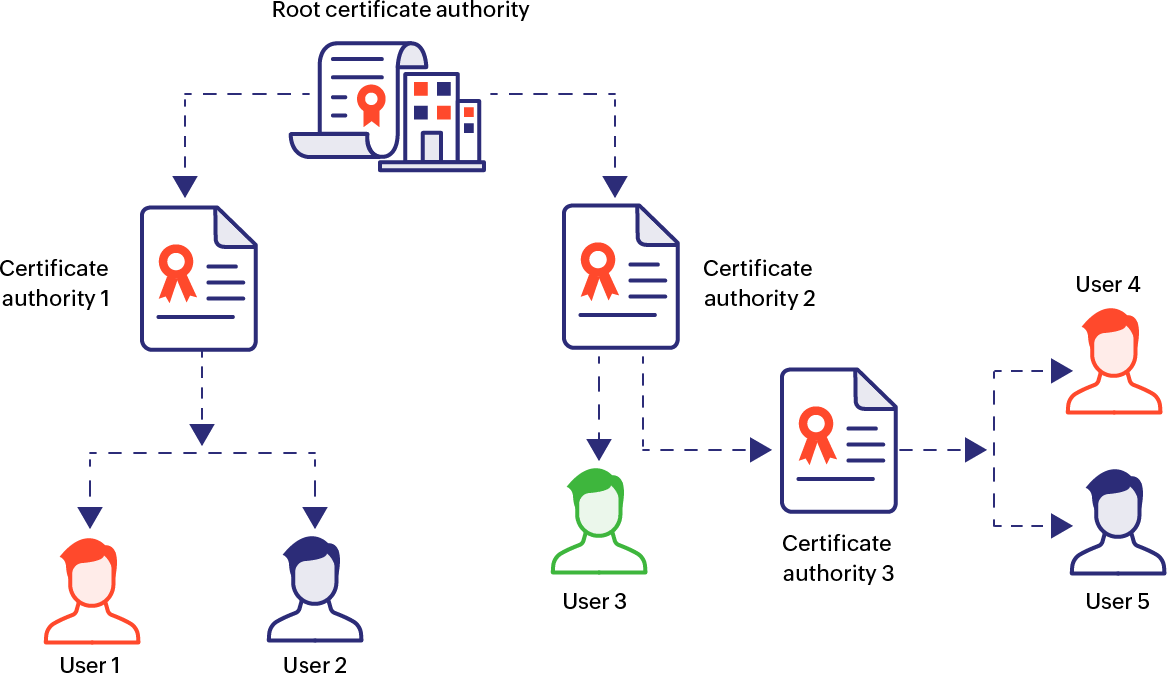
- 02
Single CA model
The single CA model, like the name suggests, involves only one CA. There is no intermediate CA or certificate between the issuing CA and the end-server. This model poses a risk of collapse; should the private key of the root certificate be altered, all certificates issued by the root CA have to be replaced.
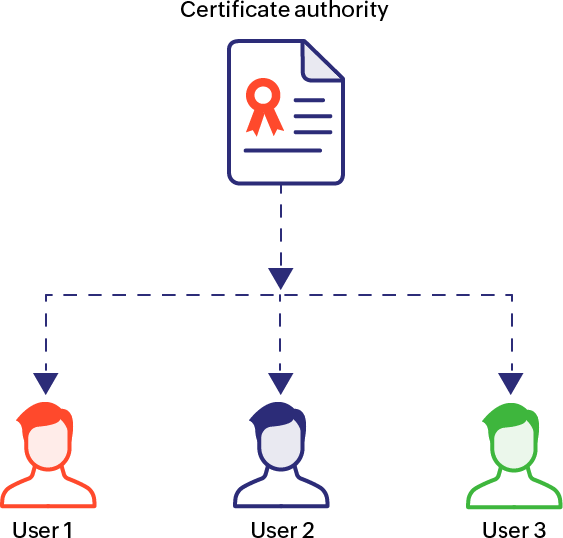
- 03
Bridge model
The bridge model involves the root CAs of multiple hierarchical PKI trees/domains connected to each other through one or more bridge CAs. The bridge CAs act as a bidirectional hub for peer-to-peer trust verification between different CAs and establishes trust between different PKI domains. This establishes trust between different PKI domains such that digital certificates of one PKI domain are trusted by entities in the other, enabling secure communication.
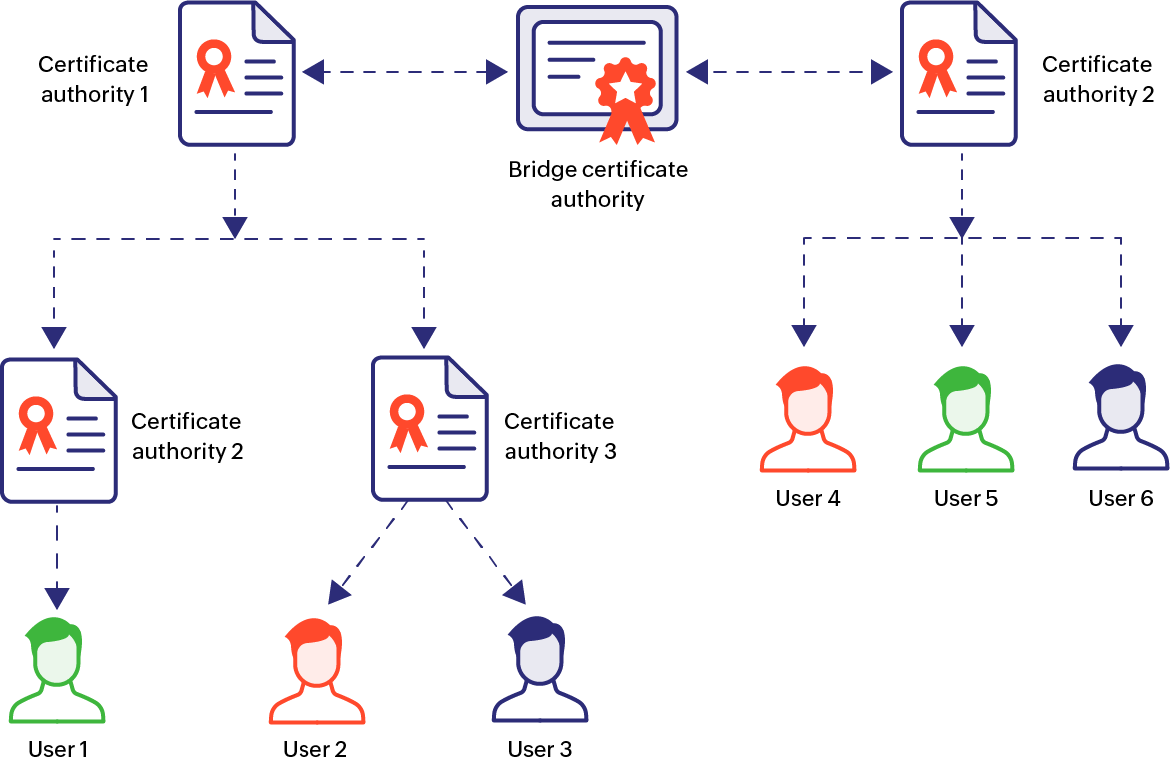
- 04
Mesh model
Unlike the hierarchical or bridge models, the mesh model has a decentralized trust system, where every local CA serves as a trust anchor in its own right. In the mesh model of PKI, different CAs are interconnected with each other, where they verify information in a bidirectional manner with other CAs connected to them. Since there is no root CA or a superior trust anchor based on hierarchy, the mesh model of PKI does not entail a single point of failure.
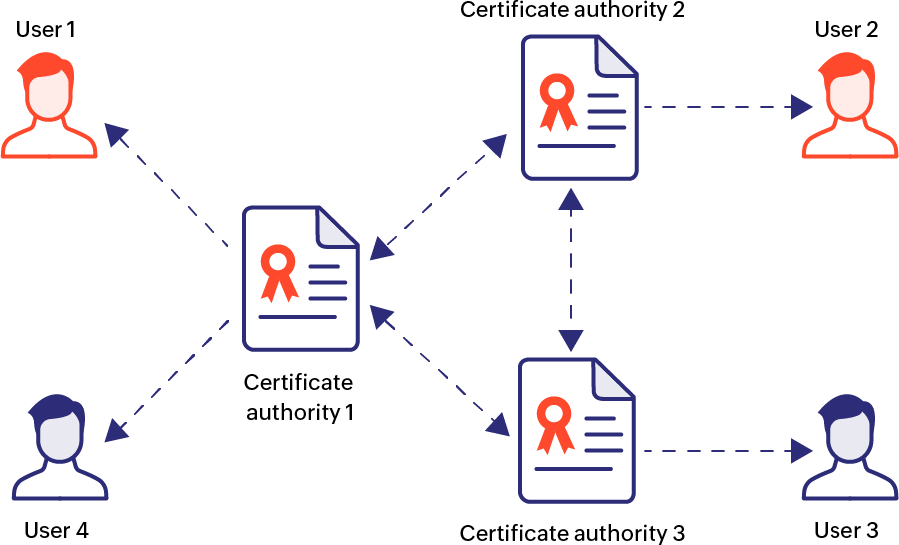
- 05
Hybrid model
The hybrid model of PKI is a blend of the different models we have seen above. It utilizes characteristics of the hierarchical, bridge, and mesh models where suited in its architecture. The hybrid model is largely built to be flexible—depending on different organizational needs—making it agile and scalable.
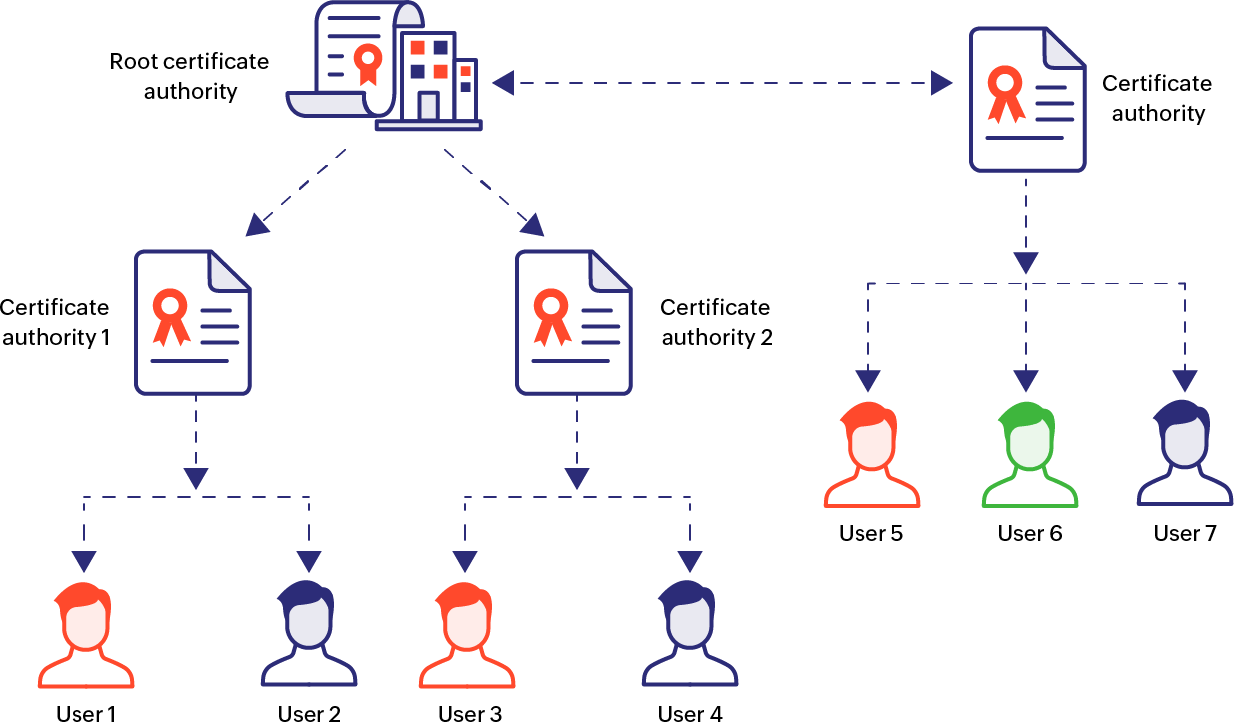
What is the role of digital certificates in PKI?
SSL/TLS certificates are a fundamental component in ensuring secure web-based communication. They are typically used to establish encrypted communication between a web server and a web browser/client. They protect the integrity of the information that is transmitted and prevent data tampering.
SSL/TLS certificates can be broadly classified into three main subtypes:
- Domain validation (DV) certificates: These certificates are used verify if the certificate holder has control over the domain. They are the most basic form of SSL/TLS certificates and are usually used for smaller blogs/websites.
- Organization validated (OV) certificates: Along with verifying the ownership of a domain and if the certificate holder has the rights to use the domain, OV certificates also verify organizational information.
- Extended validation (EV) certificates: These certificates are subjected to a stringent validation process. EV certificates verify organizational details of the certificate holder such as their legal status and physical existence.
What are the different ways in which SSL/TLS certificates are used in PKI?
- Code signing certificates: Code signing certificates are certificates that are signed by software developers to certify their code or application, and verify their ownership. The purpose of code signing certificates is to ensure that the code hasn't been tampered with, and verifying that it can be safely downloaded and used.
- Email signing and encryption certificates: Email signing certificates or secure/multipurpose internet mail extensions (S/MIME) certificates are signed to verify the authenticity of the sender and to protect against email spoofing. While email encryption certificates are used to encrypt email messages to maintain privacy of the contents of the email. They encrypt email messages using the recipient's public key such that only the recipient's private key can decrypt it.
- Client authentication certificates: Client authentication certificates help authenticate a client—digital entity such as a user or device—and verify their identity. Client authentication certificates convey to the server that the client is trying to connect to, that the client is who they say they are and can be trusted. Servers can implement access control restrictions based on the client certificate.
- Server authentication certificates: Server authentication certificates are SSL/TLS certificates used to verify the identity of servers when clients attempt to connect to it. Clients (for example, web servers) can verify that they are connecting to the right server (website) and not an imposter or malicious site.
What are the challenges that Public Key Infrastructure solves?
Strong cryptography and digital certificates play a vital role in securing modern enterprise infrastructure, but managing them efficiently across a large organization poses significant challenges. Without proper PKI implementation, organizations struggle with authenticating users and devices, securing communications, and maintaining compliance with security standards. The lack of robust certificate management can lead to unexpected certificate expirations, security breaches, and service disruptions.
As organizations increasingly rely on digital transactions and remote access, the need for reliable identity verification and encrypted communications becomes paramount. Traditional password-based systems are vulnerable to various attacks, while manual certificate management processes are error-prone and resource-intensive. The complexity multiplies when dealing with numerous endpoints, applications, and services spread across different networks and locations.
Public Key Infrastructure (PKI) addresses these challenges by providing a framework for managing digital certificates and encryption keys throughout their lifecycle. It enables organizations to establish trust relationships, secure sensitive data transmission, and implement strong authentication mechanisms. PKI automates many aspects of certificate management, reducing human error and ensuring timely certificate renewals. This systematic approach helps organizations maintain security standards while scaling their digital operations efficiently.
PKI best practices
Implementing a robust Public Key Infrastructure (PKI) requires careful planning and adherence to industry-proven best practices. Some of these best practices include:
- 01
Secure private keys with hardware security modules (HSMs)
Private keys are the cornerstone of PKI, so protecting them is critical. Use HSMs to store private keys securely, as they provide a high level of security and physical protection. Limiting access and enforcing strict controls around HSMs can further reduce the risk of key compromise.
- 02
Use strong cryptographic algorithms and key lengths
To protect against modern threats, utilize strong encryption algorithms such as RSA-2048 or ECDSA with P-256 and SHA-256 for hashing. Regularly review and update algorithms and key lengths as cryptographic standards evolve, to stay resilient against emerging vulnerabilities.
- 03
Define a strong PKI policy and governance
Establish clear PKI policies that outline roles, responsibilities, and procedures for certificate issuance, renewal, revocation, and key management. Ensure all policies comply with industry standards and legal regulations. A well-documented policy helps maintain consistent security measures across the organization.
- 04
Automate certificate lifecycle management
Automate certificate provisioning, renewal, and revocation processes to minimize the risk of certificate expiration and outages. Effective lifecycle management prevents security incidents and ensures continuous protection by maintaining the validity and authenticity of certificates.
- 05
Implement access controls and auditing for PKI components
Enforce strict access controls for PKI components, ensuring only authorized personnel can access sensitive systems. Regular audits and logging are essential to detect unauthorized access attempts and maintain accountability. Auditing also helps in compliance and ensures PKI integrity over time.
- 06
Disaster recovery and business continuity
A comprehensive disaster recovery and business continuity plan is crucial for maintaining PKI operations during critical situations. Organizations must establish clear procedures for responding to key compromises and maintain secure offline backups of all critical PKI components. Regular testing of recovery procedures ensures their effectiveness and helps identify potential gaps in the recovery process.
Common use cases of public key infrastructure (PKI)
- 01
Secure email communication
Email PKI enables users to digitally sign and encrypt their messages, ensuring confidentiality and authenticity in business communications. Using protocols like S/MIME, recipients can verify the sender's identity and be confident that the message hasn't been tampered with during transmission.
- 02
Digital certificates for websites
Website certificates form the backbone of secure internet browsing by enabling HTTPS connections that encrypt data between browsers and servers. When users visit a website with a valid certificate, they see the padlock icon indicating a secure connection, protecting sensitive information like passwords and credit card details. This PKI implementation is crucial for e-commerce, online banking, and any service requiring secure data transmission.
- 03
Code signing
Code signing certificates allow software developers to sign their applications digitally, proving their identity as the legitimate publisher and ensuring code integrity. When users download or install signed software, their operating system can verify the signature and warn them if the code has been modified since it was signed. This protection is essential in preventing malware distribution and maintaining trust in software distribution channels.
- 04
Document signing
Digital document signing enables paperless workflows by providing legally binding electronic signatures that are impossible to forge. Each signature is uniquely tied to both the signer and the document content, creating a tamper-evident seal that maintains document integrity. This technology has revolutionized contract management, legal proceedings, and government services by reducing processing time from days to minutes while maintaining security and authenticity.
- 05
Internet of things (IoT)
In the internet of things ecosystem, PKI provides a scalable way to authenticate and secure millions of connected devices. Each device receives a unique identity certificate, enabling secure communication with other devices and central management systems. This infrastructure is crucial for protecting smart homes, industrial IoT deployments, and critical infrastructure from unauthorized access and tampering.
- 06
Internal IT infrastructure
Organizations use PKI to secure their internal networks by issuing certificates to servers, workstations, and network devices. These certificates enable secure authentication and encrypted communication between different components of the IT infrastructure, protecting sensitive data and services. The system also provides centralized control over security policies and certificate lifecycle management.
Importance of a certificate management tool in PKI
Modern enterprises usually have thousands of digital entities in their environment, all of which each have a certificate associated with them. Therefore, it becomes impossible to keep track of all of them, their expiration, renewals, and so on. If a certificate renewal is missed for example, an entire domain can go down, causing economic and reputational pitfalls to the organization. If certificates are invalid or expired, the whole public key infrastructure falls apart. Therefore, certificate management tools form an essential cog in the functioning and implementation of PKI.
A comprehensive certificate management tool like ManageEngine Key Manager Plus brings all the certificates in an enterprise environment to a central panel. Using Key Manager Plus, enterprises can manage the end-to-end lifecycles of all of their certificates. This includes, tracking certificate expiry dates and setting up alerts, creating CSRs, mapping certificates to their respective devices, tracking where they are stored, among others.